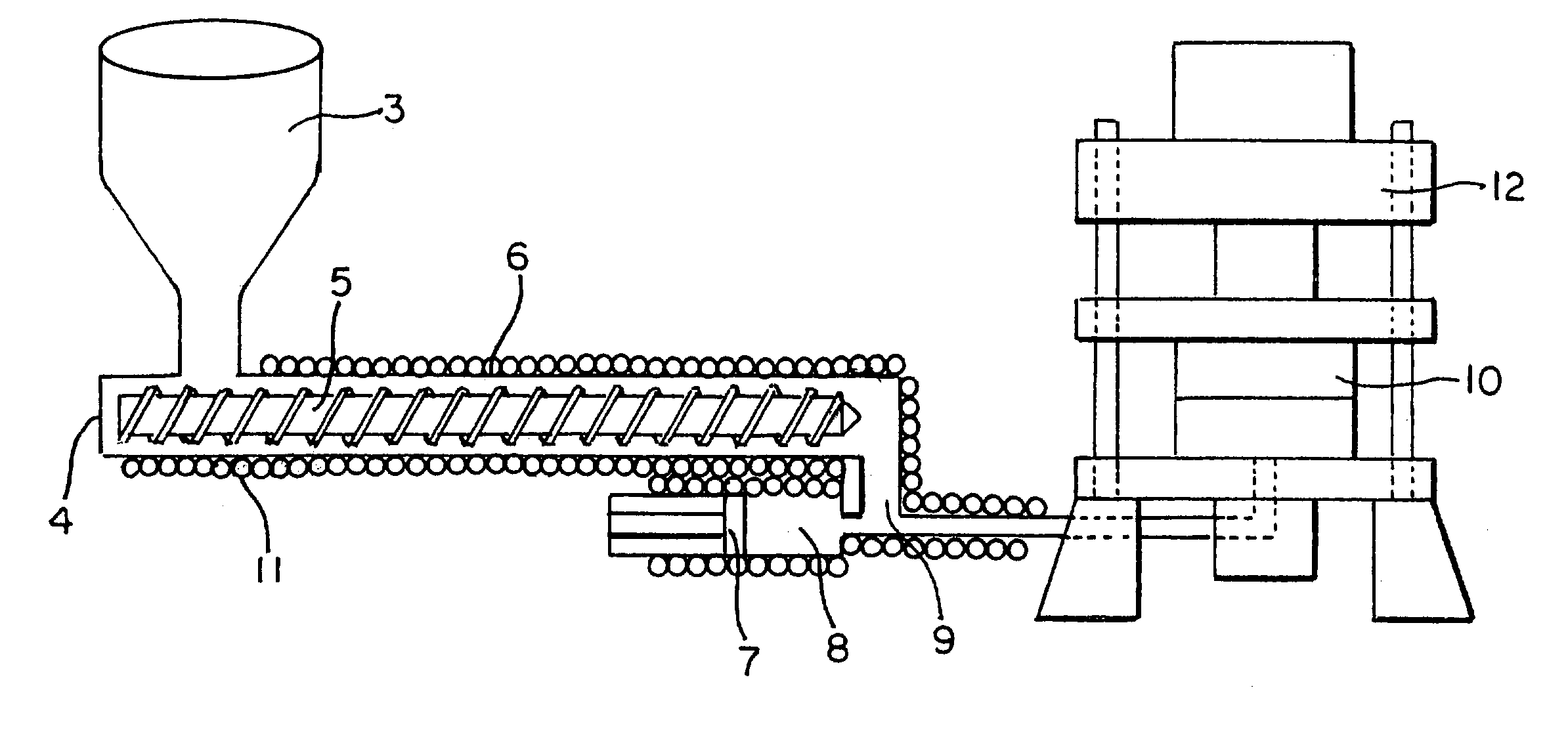Rapid densification of porous bodies (preforms) with high viscosity resins or pitches using a resin transfer molding process
- Summary
- Abstract
- Description
- Claims
- Application Information
AI Technical Summary
Benefits of technology
Problems solved by technology
Method used
Image
Examples
example 1
[0070]A 35:1 length to diameter ratio Killion extruder with 5 heating zones along the barrel was coupled directly to a heated aluminum mold. The Extruder temperature profile was as follows:[0071]Feed section=240° C. (464° F.) Zone 1[0072]278° C. (532° F.) Zone 2[0073]310° C. (590° F.) Zone 3[0074]305° C. (581° F.) Zone 4[0075]300° C. (572° F.) Zone 5[0076]305° C. (581° F.) Die Zone[0077]300° C. (572° F.) Mold
The fibrous preform was pre-heated in the mold for 2 hours until an internal temperature of 285° C. (545° F.) was reached prior to infiltration. The extruder screw was initially run at 20 rpm and reduced to 15 rpm during the run. The AR pitch resin was introduced into the extruder via a hopper and extruded into the porous fiber preform over a 2 hour period at 800–900 psi (5.52–6.21 MPa) melt pressure. The actual resin melt temperature was measured using a thermocouple located in the melt stream. The melt temperature during the infiltration was 318° C.–321° C. (604–610° F.) and i...
example 2
[0084]A non-woven porous preform was carbonized and exposed to one cycle CVD densification to rigidize the part prior to being infiltrated with resin.
[0085]The Killion extruder / mold system as described in Example 1 was used. A CVD rigidized fibrous pre-form 5 inches (12.7 cm) in diameter, 1 inch (2.54 cm) thick with a 0.5 inch (1.27 cm) hole drilled in the center was cut from a full size aircraft brake disc preform (Refer to FIGS. 1 and 2). The aluminum mold was 6 inches (15.24 cm) in diameter and 1 inch (2.54 cm) thick equipped with a 0.052 inch (1.32 mm) vent opening. The larger vent opening was used to improve the venting of resin (AR pitch) from the mold while keeping the extruder operating throughout the entire infiltration process. The objective was to keep the screw turning, maintain a constant pressure, provide a melt seal along the screw and reduce the overall run time from 2 hours to 15 minutes. The extruder settings are described below:[0086]Feed section=240° C. (464° F.)...
example 3
[0117]The injection molding apparatus described in FIG. 2 was used. The hydraulic press has a 500 ton clamping capability. The accumulator has a theoretical volume of 847 cubic inches (13,880 cm3), and the measured volume using resin is about 830 cubic inches (13,601 cm3). When completely filled with AR pitch resin, the accumulator contains approximately 37 lb. (16.8 kg) of resin. Temperatures in the extruder can be measured at 6 locations in the extruder barrel, the extruder head, the flow adapter, the accumulator head, the accumulator, the dump valve, the dump pipe, the melt pipe, the nozzle block, the nozzle extension and the feed throat. Heat is supplied to the extruder by an electrical heater and the mold is heated by hot oil circulation. The extruder screw creates pressure within the resin melt, and the pressure is maintained in the accumulator.
[0118]The part was preheated to 707° F. (350° C.) in an oven and transferred into the mold cavity just prior to infiltration. Keeping ...
PUM
| Property | Measurement | Unit |
|---|---|---|
| Length | aaaaa | aaaaa |
| Temperature | aaaaa | aaaaa |
| Temperature | aaaaa | aaaaa |
Abstract
Description
Claims
Application Information
 Login to View More
Login to View More - R&D
- Intellectual Property
- Life Sciences
- Materials
- Tech Scout
- Unparalleled Data Quality
- Higher Quality Content
- 60% Fewer Hallucinations
Browse by: Latest US Patents, China's latest patents, Technical Efficacy Thesaurus, Application Domain, Technology Topic, Popular Technical Reports.
© 2025 PatSnap. All rights reserved.Legal|Privacy policy|Modern Slavery Act Transparency Statement|Sitemap|About US| Contact US: help@patsnap.com



